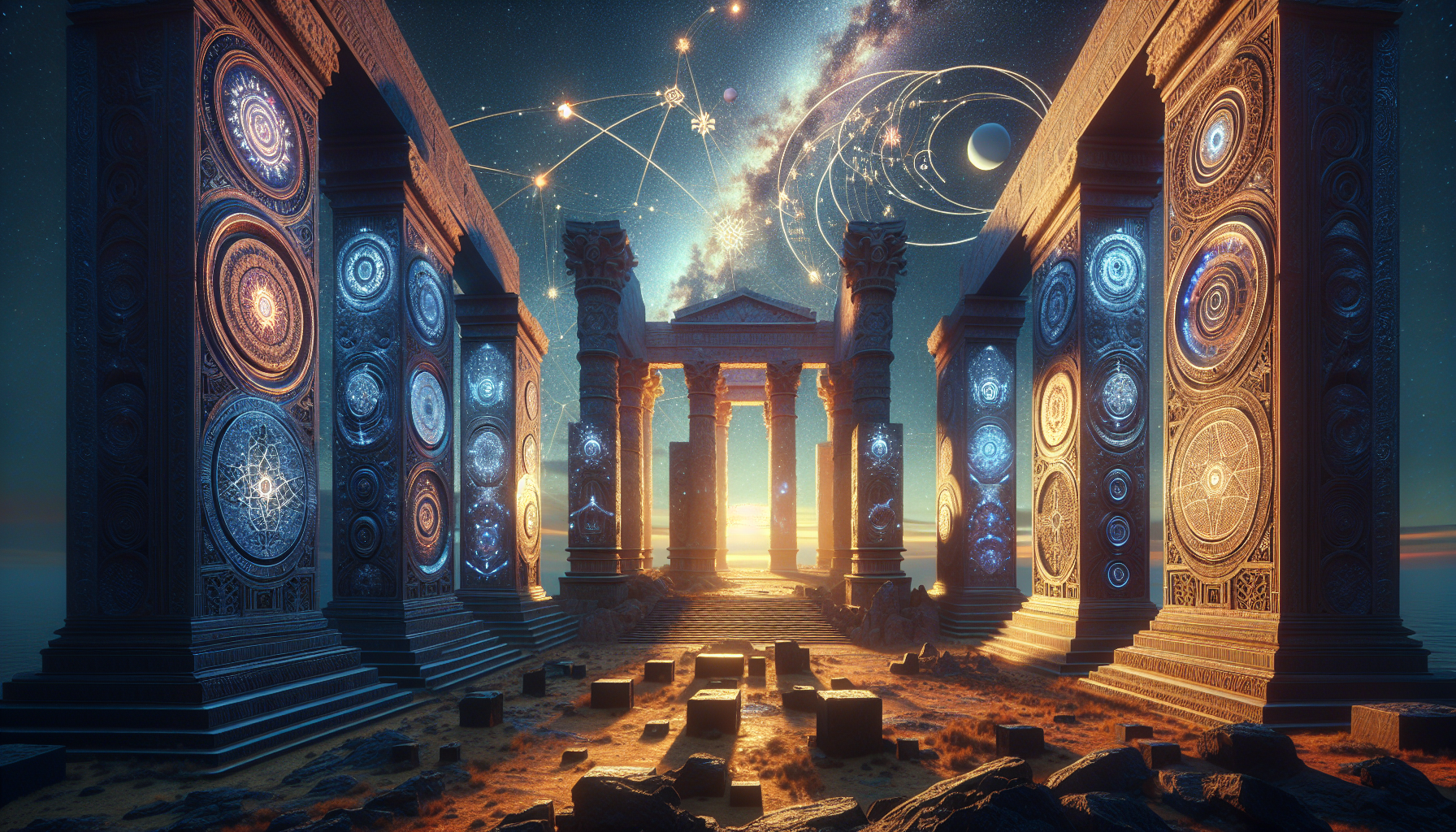In the vast expanse of the universe, celestial bodies have always captured human imagination, inspiring countless stories, myths, and artistic expressions. From the ancient pyramids of Egypt to the mysterious Stonehenge in England, the cosmos has served as both a muse and a guide for monumental art. These grand structures, imbued with cosmic symbolism, invite us to explore a rich tapestry of meaning that transcends time and space. But what is it about the stars, the moon, and the sun that has inspired civilizations across the globe to erect such awe-inspiring edifices? 🌟
In our quest to decode the cosmic code embedded in monumental art, we embark on a journey through history, culture, and the very fabric of human consciousness. Our ancestors looked to the heavens for guidance, understanding, and inspiration, often perceiving the movements of celestial bodies as divine messages or cosmic laws to be revered. This celestial dialogue is immortalized in the stones and structures that still stand today, whispering secrets of ancient wisdom and universal truths. As we peel back the layers of symbolism in these magnificent artworks, we uncover a deeper connection between humanity and the cosmos—a connection that challenges us to reconsider our place in the universe.
Throughout this exploration, we will delve into the intricate symbolism found in iconic monuments from various cultures, examining how these structures reflect their creators’ understanding of the cosmos. From the alignment of the Great Pyramids with Orion’s Belt to the solstice markers of Machu Picchu, these architectural marvels offer a glimpse into the sophisticated astronomical knowledge of ancient civilizations. We will also explore the cultural and spiritual significance of celestial motifs, investigating how they were used to convey ideas about creation, existence, and the divine order. By understanding the symbolic language of the cosmos, we gain insight into the values, beliefs, and aspirations of those who came before us.
As we unravel the mysteries of celestial symbolism in monumental art, we are reminded of the enduring power of the human spirit to seek meaning and connection in the universe. This exploration not only enriches our understanding of history and culture but also invites us to reflect on our own relationship with the cosmos. Are we merely observers of the stars, or are we active participants in a larger cosmic narrative? Through the lens of monumental art, we are inspired to ponder these questions, igniting our curiosity and expanding our horizons. Join us on this cosmic journey as we unveil the mysteries of the stars and the monumental art they have inspired. 🌌
The Interconnection of Celestial Bodies and Monumental Art
The human fascination with the cosmos stretches back thousands of years, with early civilizations dedicating significant attention to the stars, planets, and other celestial bodies. This intrigue has been intricately woven into the fabric of monumental art, providing not just aesthetic beauty, but also profound symbolic meaning. From the ancient pyramids of Egypt to the stone structures of the Maya, celestial symbolism is a recurring theme, reflecting our age-old quest to comprehend the universe and our place within it.
Monumental art has often served as a bridge between the terrestrial and the celestial, offering a tangible expression of the intangible universe. This art form has been employed to capture the essence of celestial bodies, embodying their perceived power and mystery. For instance, the Great Pyramid of Giza is aligned with the stars of Orion’s Belt, demonstrating the Egyptians’ sophisticated understanding of celestial patterns. This alignment was not merely a reflection of their astronomical knowledge but also a symbolic act intended to link the pharaohs with the divine, emphasizing the sacred nature of the rulers.
Similarly, the ancient Maya constructed their temples and observatories with an acute awareness of the movements of the sun, moon, and Venus. Their art and architecture reveal a deep connection to celestial cycles, reflecting a complex cosmology that governed their religious and social practices. These structures were designed to function as both spiritual centers and celestial observatories, reinforcing the belief that human life was intricately connected to the cosmos.
Symbolism in Ancient Cultures
Different cultures interpreted celestial phenomena in unique ways, and this is vividly illustrated through their monumental art. The Mesopotamians, for example, viewed celestial bodies as deities and incorporated them into their ziggurats, massive structures that served as both temples and astronomical observatories. The Ziggurat of Ur is a prime example, designed to represent a mountain reaching up to the heavens, symbolizing a connection between earth and sky.
In contrast, the ancient Chinese constructed observatories such as the Temple of Heaven in Beijing, where the emperor conducted rituals to ensure harmony between heaven and earth. This structure is a masterpiece of symbolic architecture, reflecting the Chinese belief in the celestial mandate, where the emperor’s right to rule was sanctioned by the heavens. The temple’s circular design represents the sky, while the square base symbolizes the earth, highlighting the balance between cosmic forces.
The symbolic significance of celestial bodies in monumental art is not just a relic of the past. Contemporary artists continue to draw inspiration from the cosmos, incorporating astronomical themes into their work. This ongoing dialogue between art and astronomy underscores the timeless allure of the stars and the enduring quest to unravel their mysteries.
Celestial Alignments and Architectural Masterpieces
Celestial alignments in architecture are a testament to the ingenuity and astronomical acumen of ancient builders. These alignments were often intended to mark significant celestial events, such as solstices and equinoxes, which held great importance in various cultures. By aligning their structures with the cosmos, ancient civilizations created spaces that were not only visually impressive but also imbued with cosmic significance.
The alignment of Stonehenge, for instance, has intrigued archaeologists and astronomers for centuries. This prehistoric monument in England is aligned with the summer solstice sunrise, suggesting its use as a solar calendar. The precise arrangement of its massive stones reflects a sophisticated understanding of celestial mechanics, as well as a deep spiritual connection to the sun.
Similarly, the ancient city of Teotihuacan in Mexico showcases a remarkable alignment with the cosmos. The Pyramid of the Sun, the largest structure in the city, is aligned with the point where the sun sets during the equinox. This alignment reinforces the pyramid’s symbolic role as a representation of cosmic order and a conduit for spiritual energy. The entire city’s layout is thought to reflect a celestial map, underscoring the importance of the heavens in the lives of its inhabitants.
Astronomical Knowledge in Ancient Architecture
The integration of astronomical knowledge into architecture is a hallmark of ancient engineering. This knowledge allowed ancient architects to create structures that not only served practical purposes but also reflected the divine order of the universe. The alignment of the Great Zimbabwe complex in Africa, for example, is believed to correspond with specific star patterns, indicating a sophisticated understanding of astronomy.
In India, the Jantar Mantar observatories, built in the 18th century, are a testament to the country’s rich astronomical heritage. These monumental structures were designed to observe celestial phenomena, and their intricate geometric shapes reflect a deep understanding of the cosmos. Each instrument serves a specific purpose, from tracking the position of stars to predicting eclipses, highlighting the advanced astronomical knowledge of the time.
The integration of celestial symbolism in architecture is a powerful reminder of the profound impact of the cosmos on human culture. It reflects our enduring fascination with the stars and our desire to connect with the universe on a spiritual level. These architectural masterpieces stand as a testament to the human spirit’s quest for knowledge and the eternal allure of the cosmos.
The Influence of Celestial Bodies on Artistic Expression
Celestial bodies have long been a source of inspiration for artists, influencing not only the form and structure of monumental art but also its content and meaning. Artists have sought to capture the beauty and mystery of the cosmos, weaving celestial motifs into their work to convey profound philosophical and spiritual concepts. This influence is evident in the art of various cultures, from the celestial motifs of ancient Egyptian tombs to the cosmic themes of Renaissance art.
In ancient Egypt, celestial symbolism played a crucial role in religious and funerary art. The depiction of the sky goddess Nut, arching over the earth with stars adorning her body, symbolizes the eternal cycle of birth and rebirth. This celestial imagery was intended to ensure the deceased’s safe passage to the afterlife, reflecting the belief that the cosmos was integral to the journey of the soul.
During the Renaissance, artists like Leonardo da Vinci and Michelangelo drew inspiration from the cosmos, incorporating celestial elements into their masterpieces. The Sistine Chapel ceiling, painted by Michelangelo, features a stunning depiction of the Creation of the Sun, Moon, and Planets, illustrating the divine order of the universe. This cosmic theme reflects the Renaissance belief in the harmony between art, science, and spirituality.
Contemporary Art and Cosmic Themes
In contemporary art, the influence of celestial bodies is as prevalent as ever, with artists exploring the intersection of art, science, and spirituality. Modern artists use astronomical themes to challenge perceptions, provoke thought, and inspire wonder. Their work often reflects a deep fascination with the mysteries of the universe and a desire to explore humanity’s place within it.
For example, the renowned artist Yayoi Kusama’s “Infinity Mirrors” series uses mirrors and lights to create an immersive experience that evokes the infinite nature of the cosmos. This installation invites viewers to contemplate the boundless universe and their connection to it. Similarly, artist Olafur Eliasson creates installations that simulate natural phenomena, encouraging viewers to experience the sublime beauty of the cosmos firsthand.
The ongoing dialogue between art and astronomy highlights the enduring power of celestial bodies to inspire creativity and reflection. As artists continue to explore cosmic themes, they invite us to consider the universe in new and profound ways, reminding us of the beauty and mystery that lies beyond our earthly realm.
Conclusion

**Conclusion: Unveiling the Cosmic Code: Exploring the Symbolism of Celestial Bodies in Monumental Art**
In this exploration of celestial symbolism in monumental art, we have journeyed through a fascinating narrative woven into the very fabric of human history. The cosmic code, hidden in the art and architecture across civilizations, reveals much about our ancestors’ understanding of the universe and their place within it. From ancient civilizations to the Renaissance and beyond, celestial bodies have not only inspired awe but have also been crucial to shaping cultural and religious ideologies.
**Recapitulation of Key Points**
Our journey began by delving into the earliest manifestations of celestial symbolism, as seen in the monumental art of ancient Egypt, Mesopotamia, and the Americas. These cultures revered the stars, planets, and other celestial phenomena as divine or semi-divine entities, often embedding them within their religious and political structures. We examined how the Great Pyramids of Egypt are thought to align with specific stars, serving both as tombs and as instruments of celestial navigation.
Moving forward, we explored the astronomical significance of Stonehenge, suggesting its use as an early calendar. The alignments of the stones with solar and lunar cycles demonstrate a sophisticated understanding of celestial mechanics, underscoring the importance of these bodies in agricultural and ceremonial contexts.
The Renaissance brought a shift in perspective, as art became a reflection of both scientific inquiry and mystical interpretation. We discussed how artists like Leonardo da Vinci and Michelangelo incorporated celestial themes into their works, often blending symbolic and literal interpretations of the heavens. This era marked a fusion of art and emerging astronomical sciences, with celestial imagery serving as a bridge between the divine and the earthly.
In contemporary monumental art, the legacy of celestial symbolism endures, evolving in tandem with advancements in technology and our ever-expanding understanding of the universe. Modern installations and sculptures, such as James Turrell’s Skyspaces and the cosmological themes in Yayoi Kusama’s work, continue to invite audiences to reflect on their connection to the cosmos, bridging the gap between ancient symbolism and modern existential inquiry.
**The Importance of Celestial Symbolism**
The symbolism of celestial bodies in monumental art is not merely an academic curiosity; it speaks to a fundamental human drive to find meaning and order in the universe. This quest has driven artistic expression for millennia, shaping cultural narratives and influencing societal development. Understanding this symbolism enriches our appreciation of art, revealing layers of meaning that transcend time and cultural boundaries.
By recognizing the interconnectedness of celestial themes across various forms of monumental art, we gain insights into the shared human experience, where the heavens have served as both a canvas and a muse. This exploration encourages us to look beyond the surface, to question, and to connect with the vastness of the universe in our own unique ways.
**A Call to Action**
As we conclude this exploration, consider the implications of celestial symbolism in your own life and community. How might you incorporate these themes into your personal or professional projects? We encourage you to share your thoughts and reflections on how celestial symbolism has influenced your perception of art, culture, and the universe. 🌌
Engage with the vibrant community of scholars, artists, and enthusiasts who continue to explore these themes. Share this article with others who may find inspiration in the cosmic code. Discuss how these ancient symbols continue to resonate in contemporary contexts, and consider how they might inspire future creations.
For further reading and exploration, consider the following resources:
– “The Oxford History of Ancient Egypt” by Ian Shaw [link currently active]
– “Stonehenge Decoded” by Gerald S. Hawkins [link currently active]
– “Leonardo da Vinci: The Complete Works” [link currently active]
These texts provide deeper insights into the rich tapestry of celestial symbolism and its enduring legacy. We hope this exploration has not only informed but also inspired you to look at monumental art through a cosmic lens, unlocking new dimensions of understanding and appreciation. ✨
Toni Santos is a visual storyteller and cosmic interpreter whose work illuminates the ancient skywatchers and their prehistoric astronomy—the profound ways early humans observed and revered the heavens before written history. Through a visionary lens, Toni explores how the stars, planets, and celestial cycles shaped myth, ritual, and survival in cultures lost to time.
Rooted in a fascination with archaic observatories, stone alignments, and celestial symbolism, Toni’s creative journey reveals the deep human impulse to understand and harmonize with the cosmos. From lunar phases guiding planting seasons to the sacred paths of the Milky Way, each of his works embodies the awe and knowledge encoded in the night sky.
Combining artistic craftsmanship with archaeological insight, Toni’s pieces evoke the mystery and precision of prehistoric astronomers. His work does more than depict—it channels the timeless dance between earth and sky, bridging ancient wisdom with contemporary wonder.
As the visionary behind Vizovex, Toni shares curated visuals, essays, and symbolic studies that invite others to reconnect with the cosmic heritage written in stone and starlight. His creations are a call to look upward, to listen to the silent stories told by the stars, and to honor the first astronomers who mapped the heavens with reverence and ingenuity.
His work is a tribute to:
The celestial wisdom of prehistoric peoples
The sacred geometry of ancient observatories
The enduring bond between human culture and the cosmos
Whether you’re a stargazer, a scholar of ancient mysteries, or someone captivated by the universe’s earliest storytellers, Toni welcomes you to journey through a space where the sky is both map and myth—one constellation, one ritual, one revelation at a time.




